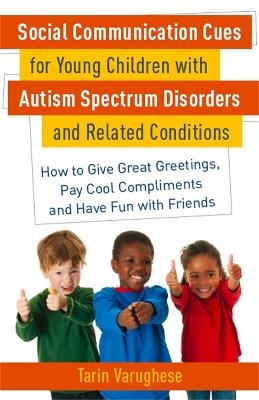
Social Communication Cues for Young Children with Autism Spectrum Disorders and Related Conditions
Jessica Kingsley Publishers (Verlag)
978-1-84905-870-4 (ISBN)
Children need effective communication skills as a foundation for successful participation in activities at home, school and in the community. Children with Autism Spectrum Disorders are often unable to learn social skills from environmental cues and require direct teaching and lots of practice.
This collection of social communication cues will enable parents and professionals to help children with social development difficulties navigate their social world and enjoy interacting with their peers. Each section begins with a simple social rule; the reason why the child may be having difficulty in this area is explained; and easy communication prompts and practice ideas are provided. The younger these skills are practiced, the happier and more self-confident the child. This program is ideal for early intervention as it can be used with children aged 2 and up.
This practical guide will be an essential resource for parents, teachers, speech-language pathologists, psychologists and therapists looking for a simple program for teaching social skills to young children with Autism Spectrum Disorders.
Tarin Varughese is a speech-language pathologist and strong proponent of early intervention. She holds a Master’s Degree in Communicative Disorders from the University of the Pacific in Northern California. She has worked with children for going on 20 years. For the last 12 years she has focused her attention on helping children with Autism Spectrum Disorders and Sensory Processing Disorders to improve their communication abilities and develop improved social skills. Tarin lives in Davis, California, with her husband and two sons.
Introduction. 1. Initiating Social Interaction. Rule 1: Greeting Others. Rule 2: Initiating Joint Attention. Rule 3: Asking for Help. Rule 4: Responding to Comments. Rule 5: Sharing Ideas/Accomplishments. Rule 6: Asking Questions. Rule 7: Getting Clarification. Rule 8: Asking Someone to Play. Rule 9: Initiating Conversation. Rule 10: Repairing Misunderstandings. 2. Maintaining Social Interaction. Rule 1: Small Transitions. Rule 2: Large Transitions. Rule 3: Maintaining Play. Rule 4: Turn-Taking. Rule 5: Watching Peers at Play. Rule 6: Organizing Play. Rule 7: Deciding who Goes First. Rule 8: Negotiating. Rule 9: Navigating a “Bump in the Road”. Rule 10: Exiting a Game. 3. Body Positioning. Rule 1: Staying with the Group. Rule 2: Exiting the Group. Rule 3: Body Positioning. Rule 4: Using your Words not your Body. Rule 5: Requesting and Waiting for the Answer. Rule 6: Personal Space. 4. Perspective Taking. Rule 1: Thinking about Others. Rule 2: Use of Pronouns. Rule 3: Positioning of Objects/Items. Rule 4: Effecting Emotions of Others. Rule 5: Acknowledging Comments. Rule 6: Reading Body Cues. Rule 7: Clarifying “Why Are you Laughing?”. Rule 8: Expressing Empathy. 5. Visual Modality. Rule 1: Listening with Eye Contact. Rule 2: Speaking with Eye Contact. Rule 3: Using Eyes to Ask Yes/No Questions. Rule 4: Entering Play Already Underway. Rule 5: Localizing Sound with Eyes. Rule 6: Shifting Eye Gaze when in Group. Rule 7: Using Eye Gaze to Track. 6. Emotional Regulation. Rule 1: Understanding Likes/Dislikes. Rule 2: Tone of Voice. Rule 3: Understanding one's own Emotions. Rule 4: Understanding Emotions of Others. Rule 5: Appearance of Emotions on Self. Rule 6: Emotional Situations. Rule 7: Embarrassment. Rule 8: Human Relatedness. 7. Development of Humor. Rule 1: Understanding Rules of Laughter. Rule 2: Power of Humor. Rule 3: Literal v. Nonliteral Language. Rule 4: Experimenting with Humor. Rule 5: Effect of Humor on Others. Social Skills Check List. Bibliography.
| Verlagsort | London |
|---|---|
| Sprache | englisch |
| Maße | 140 x 215 mm |
| Gewicht | 188 g |
| Themenwelt | Sachbuch/Ratgeber ► Gesundheit / Leben / Psychologie ► Lebenshilfe / Lebensführung |
| Sachbuch/Ratgeber ► Gesundheit / Leben / Psychologie ► Schwangerschaft / Geburt | |
| Geisteswissenschaften ► Psychologie ► Persönlichkeitsstörungen | |
| Medizin / Pharmazie ► Gesundheitsfachberufe ► Logopädie | |
| Medizin / Pharmazie ► Medizinische Fachgebiete ► Neurologie | |
| Medizin / Pharmazie ► Medizinische Fachgebiete ► Pädiatrie | |
| Sozialwissenschaften ► Pädagogik ► Sonder-, Heil- und Förderpädagogik | |
| ISBN-10 | 1-84905-870-9 / 1849058709 |
| ISBN-13 | 978-1-84905-870-4 / 9781849058704 |
| Zustand | Neuware |
| Haben Sie eine Frage zum Produkt? |
aus dem Bereich


